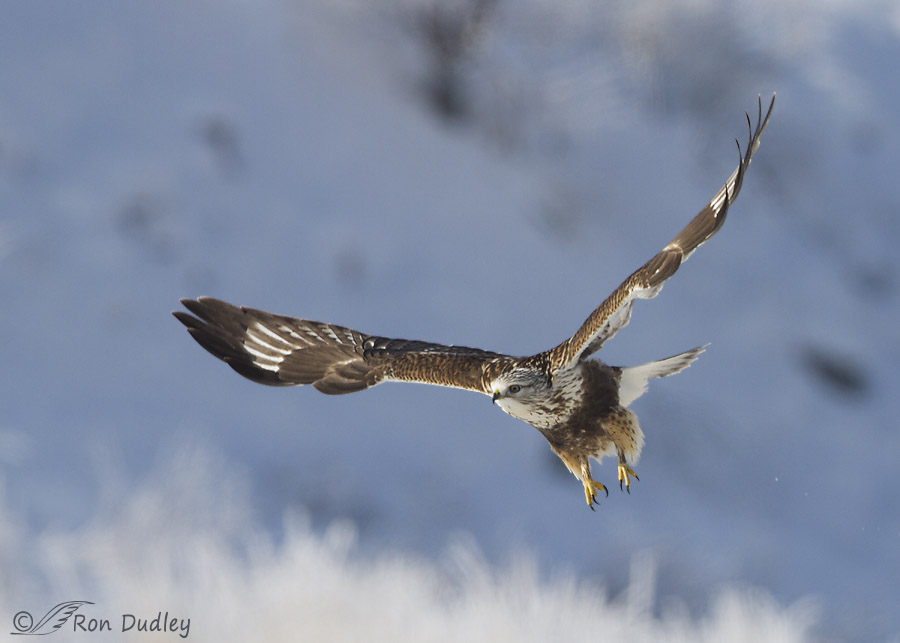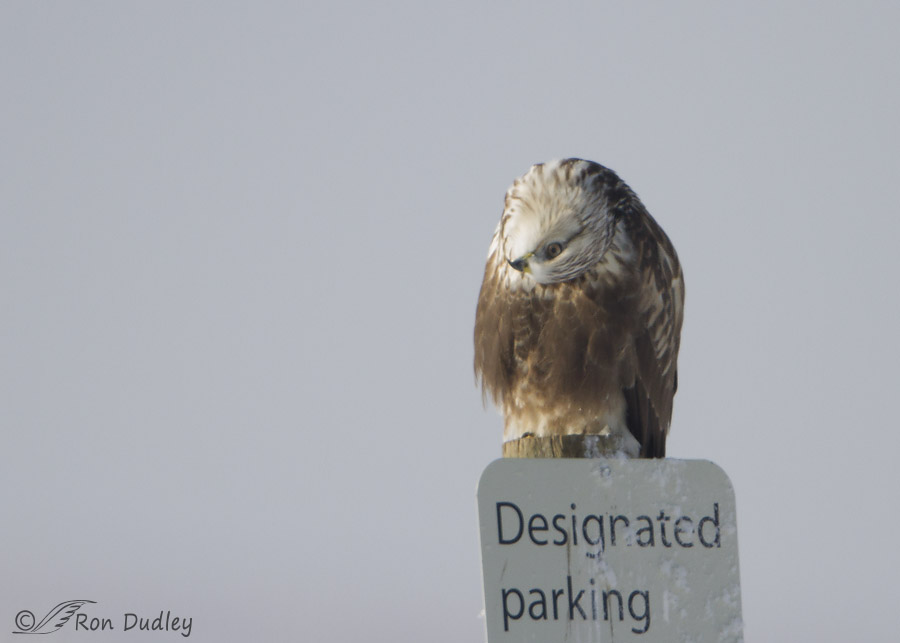The Rough-legged Hawk is a true arctic species so images of them in a frosty and snowy setting can seem appropriate and appealing.

1/2500, f/7.1, ISO 640, Canon 7D, Canon EF500mm f/4L IS USM +1.4 tc, not baited, set up or called in
I photographed this one soon after it took off from a sign along the causeway to Antelope Island on 1/3/13. It was very cold, there was snow on the ground and the vegetation along the causeway was covered with hoarfrost as you can see at the bottom of the frame.
But even a classy, elegant bird like this one can transform from the sublime to the ridiculous.

1/2500, f/5.6, ISO 640, Canon 7D, Canon EF500mm f/4L IS USM +1.4 tc, not baited, set up or called in
Here’s the same bird eight minutes earlier before it took off from the sign. Notice that its head is upside down (the curved beak is pointing upward). I suspect that it was parallaxing though I don’t know that for sure. If so it’s something I rarely see to this extreme in buteos though I’ve often seen it in young owls. (here’s a link to a Burrowing Owl youngster parallaxing if you’re interested).
Whatever the hawk was doing I was thoroughly amused as I watched it through my lens.
Ron


Love it!
Charlotte
That first shot is absolutely gorgeous! The second one proves that my new glasses are long overdue – I can’t for the life of me see that the head is upside down. Definitely an intelligent bird, though, no matter how goofy it looks, because it parked on a parking sign…
Susan, Concentrate on the beak with its point pointing up instead of down (as it normally does). Once your brain sees that the beak is upside down the rest should come into place for you.
I wish that worked, Ron. The only thing that helps is that I can see the ridge that should be above the eye. I can’t seem to make out the beak details.
Loved them both. I have never seen a Hawk contort his head and neck like that. It’s always so nice to learn something new. Must be nice to have your own parking space.
Jean, these hawks “park” here fairly often during winter – taking the sign literally I guess…
You know what drew my eye in that flight shot.
And even a hawk is entitled to some down time…
“You know what drew my eye in that flight shot.”
Yep, I sure do, EC. I thought about you when I was processing the shot and noticed the “britches”.
Ron—these shots and the link you provided are wonderful education for this non-photographer– up to this point, all I knew about “parallax ” was the horrible skewed parallelograms I got when I first attempted to photograph paintings with a primitive zoom lens ! I loved learning that this effect is helpful to birds , and also funny to see……
Good! I’m happy to learn that you found the parallax info interesting, Kris.
Dick has it exactly right. And the vision of these birds is incredibly sharp in that portion of the retina. However, it is the cones that are responsible for sharpness and color. Rods can detect lower levels of light and are far less numerous in these birds. In the fovea (the portion of the retina where vision is the sharpest, sometimes called the macula) of the human eye there are approximately 200,000 cones per square millimeter. In these birds the fovea has over 1,000,000 cones per square mm! That provides amazingly sharp resolution. Very acute detail is seen, but NOT magnifacation, which is little, if any, more than we have. Additionally, there two fovea in many raptors, one in the upper portion (which sees the ground below) and one toward the rear (which sees light coming from the front). In some, the fovea is not a round pit, but a line which may help see the horizon clearly without the need to turn the head. Even the portions of the retina away from the fovea can have over 400,000 cones per square mm, far superior to the sharpest portion our eyes. And it’s not just raptors with such amazing vision. Flycatchers, swallows, and many other birds have a similar number of cones in the fovea of their retinas. (Ever tried to see a tiny insect flying some distance from you?). A House Sparrow has relatively poor vision for a bird and it has over 450,000 cones per square mm in its retina. And they all also see Ultravilolet light (but that’s another topic). Birds have truly amazing vision.
Dan Gleason
Fascinating stuff, Dan. Thanks to both you and Dick for providing it. I just wish the lens I’m using now (until my 500mm is fixed and returned) had resolution that even approached that of birds.
Ah dear – posture while sitting… a challenge for us all! Actually, I really appreciated Dick Ashford’s comment about head and neck contortions to gain access to more sensory cells. The neck is an under-appreciated portion of us, really, for the benefits it provides us, species by species.
Alison, our necks are easy to take for granted, at least until we get a crick in it and then we become VERY aware…
Hi Ron,
Great images of one of my favorite hawks. A true representative of the far north.
I don’t know if this is a fact, but one of my mentors told me years ago that the reason hawks perform head and neck contortions when perched is that they have more sensory cells (rods and cones) in the upper hemisphere of their eyes than in the lower hemisphere. This adaptation helps a hawk hunt from high elevation/altitude when scanning the ground for prey, and causes the bird to invert its head when it wants a better look at the sky above it. For example, I have seen hawks do this when another bird flies over. So, there you go – I have never researched this “factoid” but regularly repeat it to others.
Thanks again!
Cheers,
Dick
Interesting, Dick. That one’s new to me. Makes sense if the rod and concentrations are as you say they might be.
I laughed out loud at this.
So did I, Arwen – to the point that I almost missed the takeoff shots.